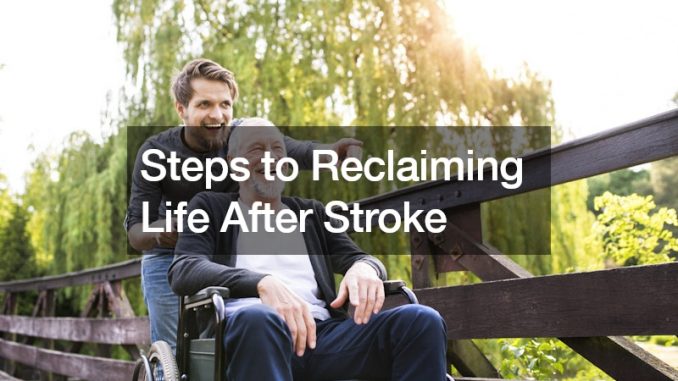

Experiencing a stroke can be a life-altering event, impacting not only physical health but also mental and emotional well-being. However, it’s crucial to remember that there is life after stroke. With determination, support, and the right strategies, stroke survivors can embark on a journey of recovery and reclaim their lives. In this comprehensive guide, we’ll explore the essential steps to navigating life after stroke and regaining independence and fulfillment.
1. Prioritize Physical Activity and Mobility
Physical activity plays a pivotal role in stroke recovery, aiding in the restoration of mobility and overall well-being. Setting realistic goals and starting small are key to establishing an exercise routine post-stroke.
Whether it’s daily walks, stretching exercises, or incorporating movement into everyday tasks, consistency is paramount. Remember, even a few minutes of exercise each day can make a significant difference over time.
Moreover, for individuals requiring additional assistance, considering home services can offer tailored support in the journey towards reclaiming mobility. These services provide personalized guidance and aid in navigating the challenges of post-stroke recovery, fostering an environment conducive to progress and independence.
2. Communication Strategies for Aphasia
Aphasia, a language impairment commonly experienced after a stroke, can present challenges in communication. However, there are various strategies that can help improve understanding and expression. Utilizing visuals, gestures, and simple language can facilitate communication. Patience, both for the survivor and their loved ones, is essential, as progress may be gradual. Creating a supportive environment where communication is encouraged and frustration is met with understanding is crucial for effective interaction.
3. Social Reintegration
Maintaining social connections and engaging in meaningful activities are vital aspects of post-stroke recovery. Reconnecting with friends, family, and community through support groups or leisure activities can provide invaluable emotional support and a sense of belonging. It’s essential for stroke survivors to advocate for their needs and seek assistance when necessary, whether it’s accessing support groups or exploring new hobbies that promote social interaction.
4. Cognitive Rehabilitation
Cognitive challenges, such as memory loss and difficulty with attention and perception, are common after a stroke. Structuring activities, repeating information, and simplifying tasks can aid in cognitive rehabilitation. Establishing routines and utilizing tools like calendars and reminders can help manage daily tasks more effectively. Embracing a growth mindset and celebrating progress, no matter how small, is key to fostering resilience and adaptability in the face of cognitive challenges.
In addition to employing structured activities and task simplification, engaging in cognitive exercises tailored to specific challenges can further aid in rehabilitation. These exercises may include puzzles, word games, or digital applications designed to stimulate cognitive function and enhance memory retention. Furthermore, incorporating mindfulness practices and relaxation techniques can help alleviate stress and improve focus, contributing to overall cognitive well-being. It’s important to recognize that cognitive rehabilitation is a dynamic process that requires patience and perseverance. By embracing a holistic approach that encompasses both mental and emotional aspects, individuals can navigate cognitive challenges with greater resilience and confidence, paving the way for a fulfilling post-stroke life.
5. Emotional Support
The emotional impact of stroke, both for survivors and their caregivers, should not be overlooked. Mood changes, anxiety, and feelings of isolation are common experiences post-stroke. Seeking emotional support from friends, family, or professional counselors can provide a much-needed outlet for expressing concerns and frustrations. Engaging in activities that promote relaxation and stress management, such as meditation or creative expression, can also contribute to emotional well-being.
6. Adopting Healthy Lifestyle Choices
Maintaining a healthy lifestyle is essential for preventing future strokes and promoting overall well-being. Making mindful choices regarding diet, exercise, and substance use can have a profound impact on long-term health outcomes. Incorporating nutritious foods, engaging in regular physical activity, and managing stress effectively are all pillars of a healthy lifestyle post-stroke. Additionally, quitting smoking and moderating alcohol consumption can further reduce the risk of stroke recurrence.
7. Accessing Resources and Support
Navigating life after stroke often requires access to resources and support services. From medical professionals to community organizations, there are numerous avenues available to assist stroke survivors in their recovery journey. Identifying individual needs, setting achievable goals, and reaching out for assistance are crucial steps in accessing the support necessary for optimal recovery. Whether it’s connecting with a stroke recovery group or seeking guidance from healthcare professionals, there is a wealth of resources available to aid in the rehabilitation process.
In conclusion, reclaiming life after stroke is a multifaceted journey that requires patience, perseverance, and support. By prioritizing physical and emotional well-being, embracing adaptive strategies, and accessing the necessary resources, stroke survivors can embark on a path toward renewed independence and fulfillment. Remember, every step forward, no matter how small, brings you closer to a life that is rich and meaningful post-stroke.
.
